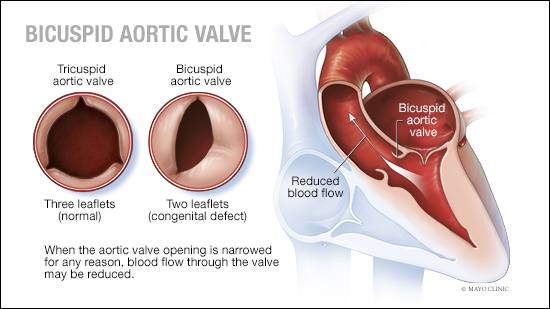-
Mayo Clinic Q & A
Mayo Clinic Q and A: Treatment and management of bicuspid aortic valve

DEAR MAYO CLINIC: I am a 29-year-old active military service member without any significant health issues. Yet during my most recent routine physical examination, it was discovered that I have a heart murmur. I was referred for an echocardiogram and evaluation with a cardiologist who said I have a bicuspid aortic valve. What are the short- and long-term consequences of having a bicuspid aortic valve? At what point should a bicuspid aortic valve be treated, and what is the treatment?
ANSWER: The aortic valve sits at the base of heart, and it separates the heart's main pumping chamber (the left ventricle) and the main artery (the aorta), which carries the oxygen-rich blood to your body. It functions as a one-way valve, opening and closing with each heartbeat, which keeps the blood flowing in the correct direction. It usually consists of three flaps of tissue — what are called valve cusps. This makes the aortic valve a tricuspid valve.
Approximately 1%–2% of the population are born with an aortic valve that only has two cusps. This is called a bicuspid aortic valve. This condition is the most common heart valve defect present at birth.
Most people with a bicuspid heart valve do not have any signs and symptoms of valve disease until they are an adult, but it occasionally can cause symptoms in childhood. It most commonly is diagnosed as an incidental heart murmur during physical examination in otherwise healthy adults or discovered while a patient is having medical tests for another health condition.
A new diagnosis of a bicuspid aortic valve usually does not require immediate intervention or have significant health effects in the short- or mid-term. It does require lifelong surveillance because it may cause heart problems in the long term. Over half of patients will need aortic valve repair or replacement within 25 years after bicuspid aortic valve diagnosis.
Most commonly, the bicuspid aortic valve results in early narrowing of the aortic valve, called aortic stenosis. This causes reduced blood flow from the heart, which creates excessive work on the heart. Sometimes the opposite can happen, and the valve does not close tightly enough, allowing backward flow of the blood into the heart and causing leakiness, or aortic regurgitation.
A narrow or leaky valve can lead to heart failure over time, causing symptoms such as chest pain, shortness of breath and difficulty exercising. Some people with bicuspid aortic valve also may develop enlargement of the aorta. The enlargement of the aorta above a certain size can lead to a rupture or tear of the wall of the aorta, which is life-threatening if not recognized or treated in a timely manner. As you can see, a bicuspid aortic valve can affect not just the valve, but also the aorta, with a wide spectrum of disease manifestations.
Most bicuspid aortic valve cases occur by chance, but approximately 10% of the cases tend to occur more often in family members. While screening of first-degree relatives is routine after the initial diagnosis of bicuspid aortic valve, routine genetic testing is not recommended.
The initial test, as in your case, is an echocardiogram. This test uses sound waves to image the heart chambers, its valves, blood flow through the valves and the size of the aorta. It is an excellent initial screening tool. An echocardiogram can reliably diagnose a leaky or narrow valve or the enlargement of the aorta. Should there be evidence of aortic enlargement, your health care provider may order a CT for more precise measurement.
Treatment of the bicuspid aortic valve depends on the extent of the valve's disease, the patient's symptoms and the size of the aorta. Open-heart surgery may be needed if the narrowing or leakiness is severe or the patient is experiencing symptoms.
The most commonly performed procedure is aortic valve replacement, with either an artificial mechanical valve or a biological tissue valve. In certain cases of a leaky valve, repair of the aortic valve may be more feasible than replacement, which is more advantageous, especially in younger patients.
During open-heart surgery, the surgeon may remove the enlarged section of aorta, if necessary, and replace it with a synthetic tube, or graft. While there are no medications for bicuspid aortic valve, your health care provider may prescribe medications to treat associated heart problems, like high blood pressure. Patients with bicuspid aortic valve are at increased risk for developing infection of the lining of the heart and the valves, so recommendations for proper, regular dental care can lower this risk.
In summary, once the diagnosis of bicuspid aortic valve is established, you will require lifelong care and surveillance by a cardiologist using an echocardiogram to monitor your valve and aorta. Since the bicuspid aortic valve can be passed down in families, your health care provider also will recommend a screening echocardiogram for your parents, siblings and children ― your first-degree-relatives. — Dr. Gabor Bagameri, Cardiovascular Surgery, Mayo Clinic, Rochester, Minnesota
****************************
Related Articles
- Mayo Clinic Q and A: Mechanical or tissue heart valve replacements published 2/26/21
- Mayo Clinic Q and A: Most aortic aneurysms are small, develop slowly published 2/7/20
- Sharing Mayo Clinic: Surviving an aortic tear and living to navigate its aftermath published 2/2/20







